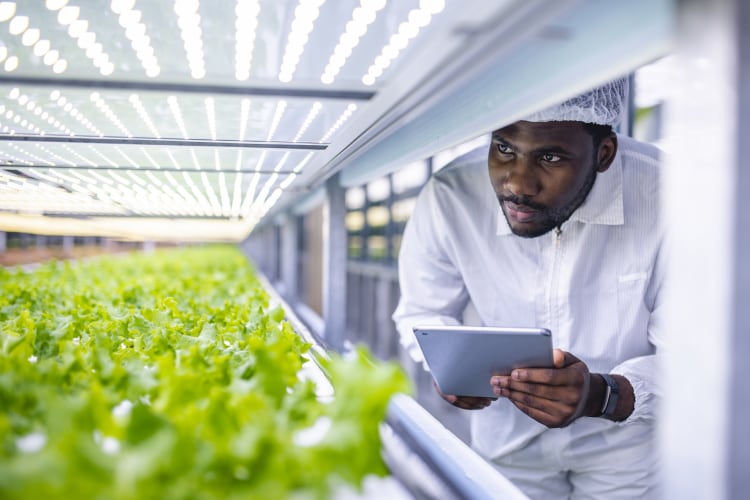While CEA systems provide unparalleled control over growing conditions, there is still a reliance on crops bred for open-field agriculture, which limits profitability and efficiency.
Therefore a new study has assessed the potential to develop new crop varieties tailored to CEA, and detailed how this could significantly improve yields, reduce operational costs, and enhance sustainability.
Breeding for CEA
One of the major breeding priorities for CEA is developing cultivars that can thrive in low-light conditions, as artificial lighting can be expensive. Breeding plants that require less light while maintaining high productivity can cut down on energy costs significantly.
Other breeding targets include improved nutrient uptake, disease resistance, and tolerance to limited space. For instance, vertical farming favours smaller canopy size to maximise space efficiency. Likewise, selecting for parthenocarpic (self-fruit-setting) plants could eliminate the need for pollinators in indoor environments.
Key crops and their potential in CEA
Additionally, the study identified several crops that could benefit from breeding tailored to controlled environments, such as lettuce and leafy greens, tomatoes, peppers and cucumbers, and strawberries.
Lettuce and leafy greens are currently dominant in CEA due to their short production cycles and high market demand. Breeding efforts focus on improved shelf life, higher nutritional content, and resistance to powdery mildew.
Tomatoes are one of the most profitable CEA crops, but existing varieties were developed for open fields. As such, the researchers suggested breeding smaller, high-yield tomato plants suited for vertical farming.
Peppers and cucumbers, on the other hand, require improved light-use efficiency and compact growth. Genetic markers for disease resistance are already available, which could help optimise these crops for CEA.
And finally, strawberries are considered high-value fruit with growing demand for indoor cultivation. Breeding priorities include enhanced fruit uniformity for robotic harvesting and better resistance to powdery mildew.
Advanced breeding technologies for CEA optimisation
Traditional breeding can take years to develop new cultivars, but emerging technologies are accelerating progress. There are now tools like genomics-informed breeding, marker-assisted selection, and precision breeding to fast-track CEA crop development.
Genome editing techniques like CRISPR are particularly promising. CRISPR can introduce beneficial traits such as compact plant size and improved light-use efficiency without affecting other aspects of the crop.
High-throughput phenotyping is also playing a role. Automated imaging and AI-driven analysis allow researchers to assess plant growth under different CEA conditions rapidly. This data-driven approach helps identify the best-performing cultivars faster than traditional field trials.
Additionally, AI and machine learning are being applied to analyse plant growth patterns, optimise breeding strategies, and even predict how different genetic modifications will affect crop performance. The researchers noted that it was now possible to process huge amounts of data to determine which traits would be most beneficial in controlled environments.
The future of CEA breeding
Looking ahead, researchers believe breeding programmes will expand beyond leafy greens, tomatoes, peppers, cucumbers and strawberries to include high-value crops such as tree fruits and other berries. With advancements in plant genetics, the study’s authors speculated that dwarf apple trees or berry bushes optimised for indoor farms could become a reality.
The study concluded that integrating breeding innovations with CEA technologies was key to maximising yield and profitability. The next step would involve collaboration between scientists, agribusinesses, and policymakers to fast-track the development and adoption of CEA-specific crops.
The researchers stated: “These advancements enable the development of crop varieties tailored to the unique conditions of CEA, contributing to more sustainable, efficient, and profitable production systems. Integrating these techniques with ongoing advancements will be crucial for developing high-quality, nutritious horticultural crops and enhancing global food security and sustainability.”
Source: National Center for Biotechnology Information
“Improvement of crop production in controlled environment agriculture through breeding?”
https://doi.org/10.3389/fpls.2024.1524601
Authors: Krishna Bhattarai, et al.


